Do-it-yourself Beko washing machine repair

Breakdown of household appliances never comes in handy. In this case, you should not panic, because if you use a Beko washing machine, then you can fix some breakdowns yourself with your own hands.
Features of Beko washing machines
Most Beko washing machines have front-loading laundry on the front panel, the dimensions of the unit can vary. Frontal loading contributes to the expansion of the design features of the machine, thanks to which the consumer has the opportunity to choose any model, up to a fully built-in one. The Beko washing machine range includes the following options:
- with standard sizes;
- compact units;
- narrow cars.

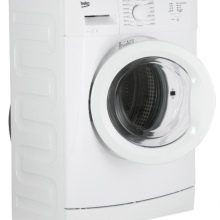
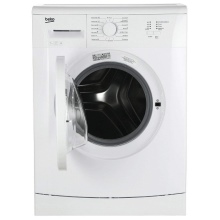
Beko home appliances can be installed in the kitchen, in the bathroom, in a spacious room or in a small room. The cost of the unit is influenced by the maximum amount of laundry. Cars with a capacity of less than 7 kilograms are much cheaper than the roomy options. Units from this manufacturer are practically silent, since they have a direct connection between the drum and the ProSmart inverter motor. In addition, this type of motor is able to save electricity by almost half. Some models have mechanical control, so the cost of such goods is cheaper. In addition to the basic options, Beko machines have the following functional features:
- quick wash at 40 degrees;
- the presence of a delicate wash mode, cleaning of children's linen, wool products, down, as well as self-cleaning.
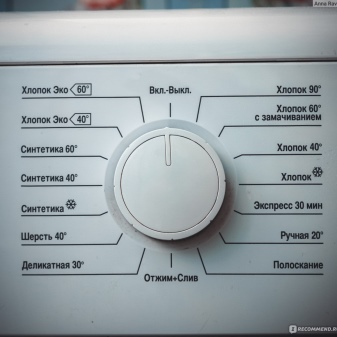

What could be the reasons?
To determine the most frequent breakdowns of Beko washing machines, the statistics of calls to the service center of this manufacturer was studied. Most often, units break down for the following reasons:
- accumulated dirt in the drain line, failure of the drain pump;
- malfunctions of the electronic module (usually statistics deteriorate due to poor quality machines);
- breakdown of the pressure switch or heating element;
- leaks;
- worn out brushes on the engine;
- the occurrence of extraneous noise during the operation of the unit.
In some cases, extraneous sounds occur when foreign objects, a broken shock absorber or a destroyed bearing enter the machine.

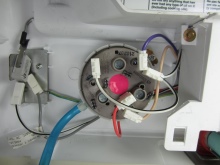
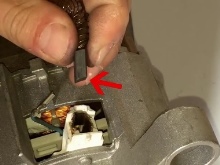
Required tools and spare parts
You can disassemble the Beko washing machine yourself using pliers and a screwdriver. However, for faster and better work, it is recommended to prepare the following tools:
- round-nose pliers or pliers;
- wrench;
- flat or cross-type screwdriver;
- awl;
- hammer;
- key equipped with socket heads.
It is recommended to use original spare parts when repairing and replacing parts on the Beko washer. In this way, the service life of the machine can be extended.
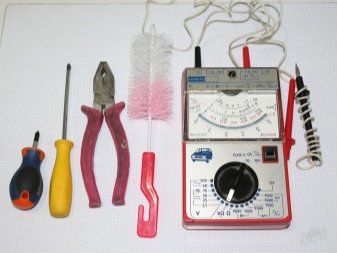
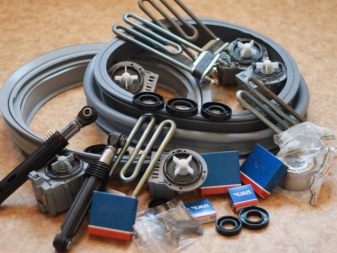
How to disassemble?
In order to start disassembling the Beko washing machine, you need to remove the cover of the upper part of the unit. Its fasteners are centered on a few bolts located at the back. To unscrew, you will need to use a Phillips screwdriver. When the bolts are unscrewed, you will need to push the cover out of the front, and then remove it.
The dispenser is removed next - for this purpose, you need to press the point in the center of the plastic tray, and then pull it towards you. Next, unscrew the screws that fix the control panel. The latter is carefully separated and laid on top of the machine. After that, remove the bottom panel by removing the bolts securing it.
The next to remove the hatch cuffs made of rubber. To do this, open the door, remove the fixing clamp. To remove it, you need to use pliers, a screwdriver, round-nose pliers. When the clamp is removed, the cuff is removed from the front wall. The last step is to clean up the retaining pieces that remain. Next, you can remove the front panel of the unit.
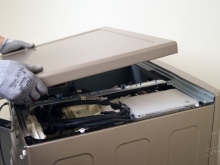
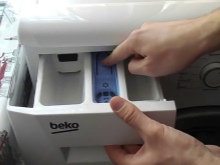
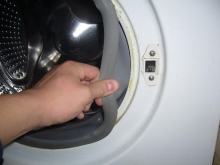
Now you can start dismantling the inlet hose suitable for the tank. For this purpose, remove the fixing clamp using pliers during the procedure. The fixing hose is removed, after which the one that goes to the water volume sensor is removed. Next, the inner clamp is removed, which is necessary to fix the cuff on the tank. After removing the cuff, you can start dismantling the rear wall of the unit, which is fastened with screws.
The next to remove the counterweights, which can be located both on the front and on the back of the "washing machine". Then the heating element is dismantled, usually it is located in the back of the car, below the tank. To remove the heating element, unscrew the fixing nut, and then press the protruding pin. The heating element needs to be pry off with something flat and carefully removed.
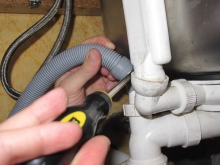
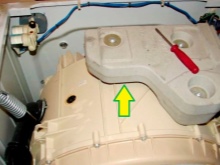

How to replace a bearing?
Replacing bearings in a Beko washing machine is a fairly simple procedure. Reasons to start checking and replacing a part:
- hum that occurs when the drum rotates;
- the presence of backlash;
- during spinning, the unit makes a lot of noise, knocks.
The above cases may indicate not only wear of the bearings, but also the breakage of the cross. To buy new bearings and other parts, it is worth knowing the exact model name of the washing machine. You can also go to the store with the bearings removed, asking the specialists to sell identical ones.
The smaller bearing should be installed on the outside of the tank; for this, it is worth removing the rear cover from the unit in advance. After baiting the first part, you can move on to the second. The bearing is installed in the hole and fixed with a blow. After installing the bearings, you can proceed with the installation of the oil seals.

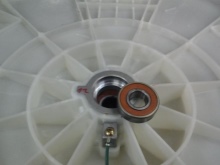
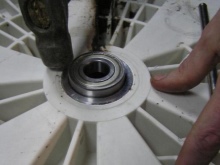
How do I clean the filter?
Preventive cleaning of the drain filter is never superfluous. Debris and dirt that gets trapped on the screen will prevent the tank from filling up with liquid correctly. Before replacing the filter, it is also worth inspecting and cleaning the hose. To clean the filter of the Beko unit step by step, proceed as follows.
- Disconnecting the washing machine from the electrical network.
- We are looking for a filter at the unit, dismantle the hatch cover or remove the false panel from the bottom of the "washing machine".
- Having prepared a rag, you can start draining the remaining liquid from the washing machine. An emergency hose can be used with this procedure.
- We are engaged in twisting and removing the filter.
- We clean and rinse the filter mesh.
- We are checking the drain pump.
- We mount the filter in its original place.
- We turn on the "washing machine" in the power grid and check it for leaks.


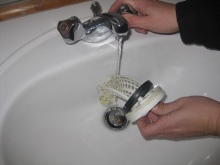
Checking and replacing heating elements
A thermoelectric heater is the part that breaks more often than others. The cause of this trouble can be scale, which was formed from poor quality water. With an excessive amount of it, the machine does its job poorly due to the fact that the scale does not give off heat well. Heating elements, which do not have the ability to give off their heat, will soon burn out. The fact that the heating element has broken down in the unit is usually indicated by the breakdown code on the display - H2, H3. To replace a part, it is worth following these steps sequentially.
- Dismantle the rear cover by loosening the bolts that hold it in place.
- Use a wrench to unscrew the fasteners and eliminate the wires that hold the heating element.
- Remove the old device with special care.
Experts recommend changing the heating element to an identical one. A temperature sensor should be installed on a new part. Do not forget about tightening the fasteners and connecting all the wiring. After collecting the washing machine, the user should check it.
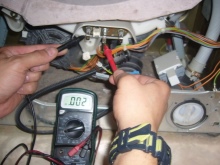

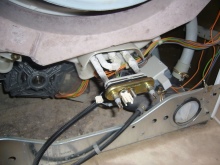
Other typical faults and how to fix them
In some cases, the owners of Beko washing machines have unpleasant moments associated with the breakdown of the water level switch, brushes for the electric motor, drum, motor. It happens when the craftsmen have to change the drain hose, hatch, pump, shock absorber, pump, board with their own hands, tighten the belt. If, after checking the heating element at home, it turned out that it is in working order, then you should think about whether the thermal sensor is functioning. In order to get it and check it, it is necessary to carry out the following measures:
- unscrew the screws to remove the top panel;
- remove the powder container and dismantle the control panel;
- use a tester to measure resistance;
- replace the broken part with a new one;
- mount the thermistor in the opposite direction.
In the event that there are problems with blocking the hatch, it is recommended to gently press down on it, and then turn on the required washing mode.
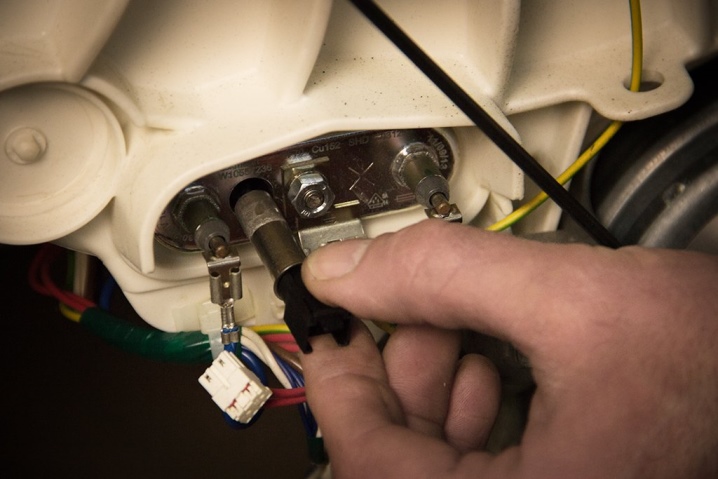
Repair Tips
Beko washing machines have some design features, thanks to which the unit can be easily disassembled:
- to change bearings, it is not necessary to take out the tank;
- to remove the drum, it will be enough to dismantle the front of the tank.
Before disconnecting the wires, it is worth recording the initial information, for example, in a photo. Thus, you can easily put them back in place. The screw connection that holds the pulley must not be removed. Experts advise to repair the Beko washing machine only in case of minor breakdowns.
- Change of a damaged part, assembly.
- Clearing the blockage.
- Cleaning the filter.
- Replacing the pump, heating element.
- Checking and replacing the intake valve.
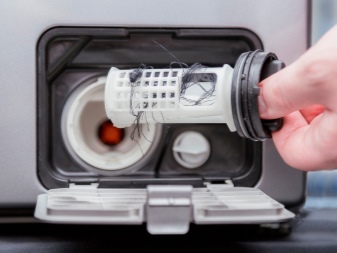
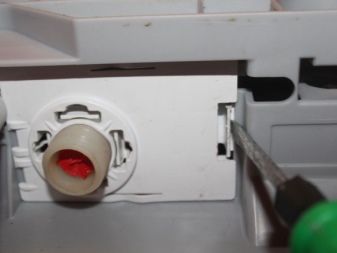
Different models of Beko washing machines have a similar structure and breakdowns. To prevent damage to the unit, it is worth using it strictly according to the instructions.
See below for details on bearing replacement.









The comment was sent successfully.